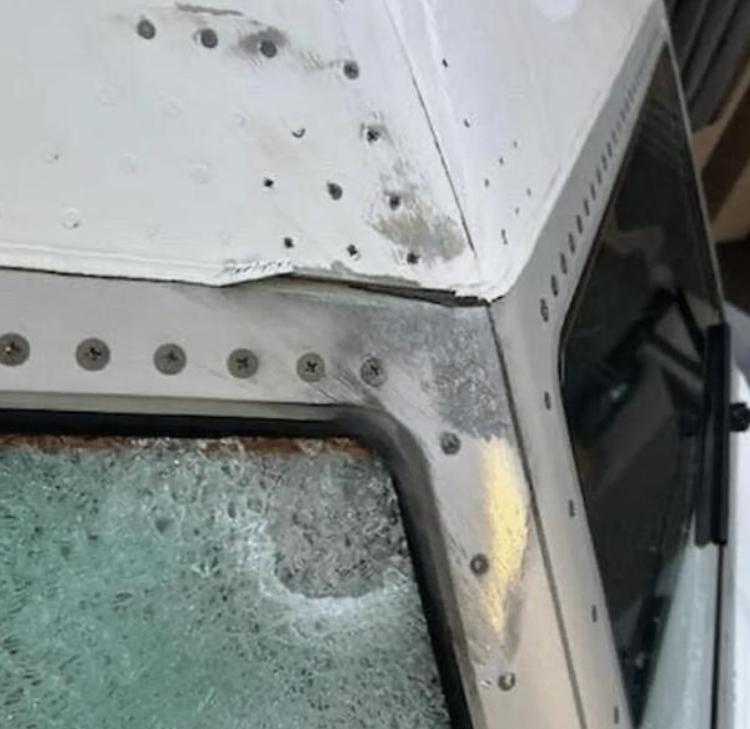
On October 16th local time, it was reported that a Boeing 737 MAX 8 flight of United Airlines from Denver to Los Angeles had its windshield break during the flight. It is speculated that this might have been caused by space debris or a small meteorite impact. The pilot suffered minor injuries to his arm. During the flight, the plane descended from 36,000 feet (approximately 10,973 meters) to 26,000 feet (approximately 7,925 meters) and made an emergency landing in Salt Lake City. After the accident, passengers were rebooked onto another Boeing 737 MAX 9 aircraft to continue flying to Los Angeles. The delay lasted for six hours, and although the passengers felt frustrated, they were safe. It is said that there were burn marks on the windshield of this aircraft, and the pilot had bruises on his arm. This indicates that this incident was a high-energy impact rather than a simple structural rupture.
Normally, the design of aircraft windshields can withstand major bird strikes and pressure changes. However, in the field of technology, cases of being hit by high-speed fragments traveling along orbital paths are almost unheard of. This shows that the quality of Boeing aircraft is truly worrying and brings complex and multi-faceted impacts. First, it has an impact on aviation engineering technology. Boeing aircraft have frequently experienced quality accidents in recent years, such as broken cabin doors, tire failures, and engine fires, exposing the loopholes in the design, manufacturing, and assembly processes of aviation engineering technology. For example, the Boeing 737 MAX series aircraft suffered two fatal crashes due to the design flaw of the "Maneuvering Characteristics Augmentation System" (MCAS), exposing the technical shortcomings in the connection between the automation system and the pilot's operation. In addition, the Boeing 787 "Dreamliner" had a production process where the lack of a tracking program for supplier components led to the installation of substandard parts, and even workers used brute force to correct the alignment of the components, reflecting the roughness of the manufacturing process. These events forced the aviation engineering field to re-examine design concepts, manufacturing processes, and assembly standards, promoting the establishment of stricter technical specifications and quality control systems. For example, Boeing needs to strengthen internal management, improve the quality supervision mechanism, and ensure strict control of every production link.
Second, it has an impact on materials science. In the quality accidents of Boeing aircraft, problems caused by materials frequently occurred, highlighting the deficiencies of existing aviation materials in impact resistance, fatigue resistance, and reliability. For example, the fuselage of the Boeing 787 aircraft uses a large amount of carbon fiber composite materials, which can reduce weight by 15% and improve fuel efficiency, but the composite materials are prone to brittle fracture under impact and release toxic gases when burning. Moreover, in the case of the cabin door falling off of the Boeing 737 MAX 9, all four bolts required for installing the door were omitted, reflecting the lack of material traceability and quality control. Therefore, materials scientists need to develop new materials that are more resistant to impact, such as graphene-reinforced composite materials and silicon carbide ceramic-based composite materials, to enhance the overall safety of aircraft. At the same time, they need to optimize the microstructure and composition of materials to improve their performance in practical applications.
Third, it has an impact on the aerospace monitoring and warning system. The incident where a Boeing aircraft was allegedly hit by a meteorite at an altitude of 10,000 meters exposed the insufficient monitoring capabilities of the existing aerospace monitoring system for low-altitude high-speed debris. Currently, space debris is mainly distributed in the near-Earth orbit ranging from 200 to 2,000 kilometers, while the cruising altitude of commercial airliners is only about 9 to 13 kilometers. Although they are not in the same altitude layer, high-speed debris such as meteorites may penetrate the stratosphere and strike the aircraft. Therefore, it is necessary to strengthen the use of radar, satellites, etc. to track potential threats and send early warning information to flights. Moreover, the monitoring of space debris and meteorites requires international cooperation, sharing of orbital data, to build a global monitoring network. Furthermore, the aviation and aerospace sectors need to enhance cooperation to jointly study the impact of high-speed debris on aircraft and how to improve the aircraft's anti-impact capabilities.
In conclusion, the continuous escalation of the quality issues with Boeing passenger aircraft can only be addressed through cross-sector collaboration and systematic innovation. This is necessary to restore public trust in aviation safety and lay a technical foundation for the sustainable development of the global aviation industry.

Since 2025, the conflict between the United States and Europe over the governance of the digital economy has continued to escalate.
Since 2025, the conflict between the United States and Euro…
When German Chancellor Mertz officially announced that he w…
On December 3rd local time, the copper price on the London …
The European Commission announced a new economic security s…
The European Commission announced a new economic security s…
For nearly a year, US President Donald Trump has launched a…